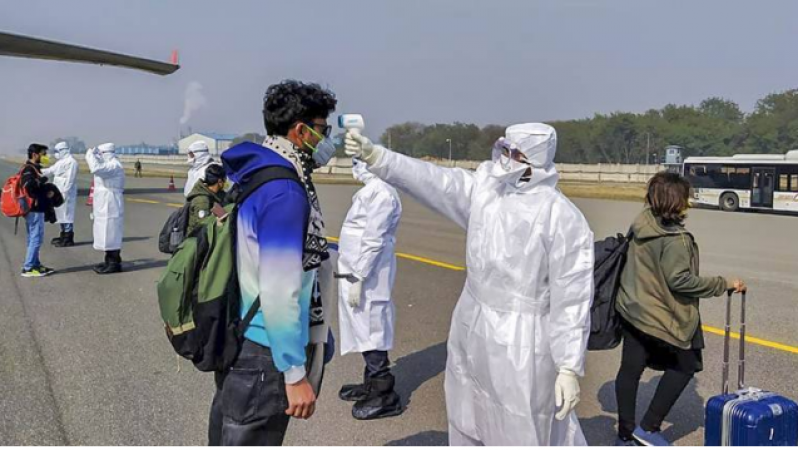
China: When the coronavirus pandemic first hit China, Shahroz Khan was in his third year of medical school at Nantong University College of Medicine and decided to move to India.
Over the next 2.5 years, online demonstrations replaced practical learning in clinical laboratories and hospitals for complex, senior-level courses such as surgery, orthopedics, and ophthalmology.
We feel this loss, of course," remarked a 23-year-old Khan from Delhi. "We should have been present and able to materialize this knowledge. We will experience that feeling forever.
Khan, who moved to Nantong in September 2017, continued to pay a rent of 1,700 yuan ($252) a month, in the hope that he would be allowed to continue his practical studies and return to China with his belongings.
But he finally left the flat in March, just three months before the end of his fifth year and the start of his final year internship.
Because we had given up on our return, the owner was forced to throw away our belongings, according to Khan, who also serves as the student coordinator for the Foreign Medical Graduates Parents Association and Indian students in China.
Every semester, we expected China to contact us again, but the students are now tired and depressed.
According to the Indian Ministry of External Affairs in May, there are about 20,000 Indian students studying in Chinese universities. Due to the similarity of curriculum between medical schools in the two countries and the affordability of Chinese medical schools compared to private Indian institutions, most students are studying medicine.
While China has allowed small groups of students from other Asian countries such as Pakistan and Sri Lanka to return, Indian students are still stranded, although the rest of the world has reopened its borders to international students.
According to Wang Wenbin, a method for the Chinese Foreign Ministry, relevant departments in China and India are in touch to make it as easy as possible for Indian students to return to China. A few days later, Ji Rong, a counselor at the Ministry of Foreign Affairs, claimed via Twitter that the first group of Indian students had already received information about plans to return from their universities.
Khan claims that although 12,000 students had requested to return to China two months ago and admitted that they would be responsible for paying their travel and quarantine costs, those students have not yet been listed.
"I don't know why China's policy is still so rigid. Why can only students return when businesses and foreign workers can return? Why are the students mainly Indian students? Asked Khan. China's foreign ministry provided an additional update on Tuesday, saying that the process has begun and "we are confident of seeing the return of the first group of Indian students in the near future," although they did not specify a specific deadline.
According to Rachita Kurmi, a fourth-year medical student at Shandong University in Jinan, the process could take up to a year, given the huge number of Indian students wanting to resume their studies in China. "If there was a first list, we would have at least had a timeline and we would have known on what basis they are allowing students to go back," said 21-year-old Mumbai resident Kurmi.
“It is expected that all Indian students will be able to return by the end of 2023 if the first batch is able to do so after the end of this year. However, this does not appear likely.
For students pursuing a Bachelor of Medicine or Bachelor of Surgery, six years of study is required in both China and India, with the final year being spent interning in hospitals affiliated with their universities.
After that, to be eligible to practice medicine in India, foreign medical graduates have to pass a screening test.
In addition, China is seen as a more reasonable option for many students after taking the National Eligibility and Entrance Test (NEET) in India, which is required for all students who wish to pursue undergraduate and postgraduate medicine. are unable to secure. Place in competitive government medical colleges.
Annual tuition for a private medical college in India can range from $25,000 to $90,000. In contrast, Khan and Kurmi pay around US$4,000 and US$6,300 annually for their respective universities.
Rachita's mother Bharatratna Kurmi said, "We found the cost of education in China more reasonable.
Bharatratna Kurmi said, "We didn't want to spend two to five crore rupees (around $252,000 to $315,000) on an Indian college. We wanted him to experience the world and develop his confidence." Impressed by the infrastructure and academic standards of Shandong University.
However, it appears that the attraction has long since warned.
China's strict zero-Covid policy is in place.
According to Ridhi Gupta, a fifth-year medical student at Xi'an Jiaotong University, students who pass the premedical entrance exam are no longer looking to enrol in medical school in China.
For many students, the financial burden and anxiety related to careers are also increasing without any clarity regarding their future.
Many Indian students also lost almost all contact with their universities after the Indian government banned 273 Chinese apps, including those used for online learning like WeChat, DingTalk, and Tencent's VooV Meeting.
According to her, the financial burden of switching to another foreign medical school is nearly identical to the financial burden of starting classes in China once more. As much as 4-5 lakh rupees (US$5,000–US$6,300) may be needed for quarantine and travel, and Rachita Kurmi's university may ask her to pay for an extra year to make up for missed clinical learning.
N.Korea sends letter to China accusing Pelosi of Taiwan trip.
Hong Kong’s Cathay Pacific Airways posts loss of HK$5-bn for FYH1-2022
.Analysts ‘surprised’ by US diplomat’s claim of Chinese drone attacks